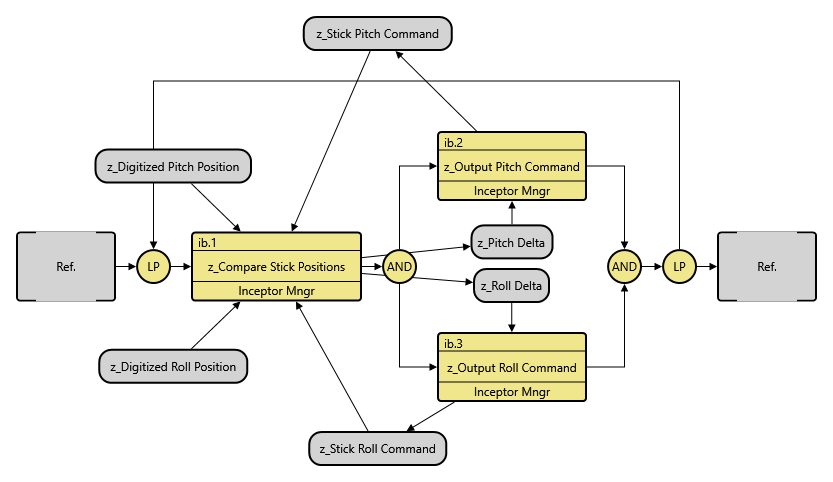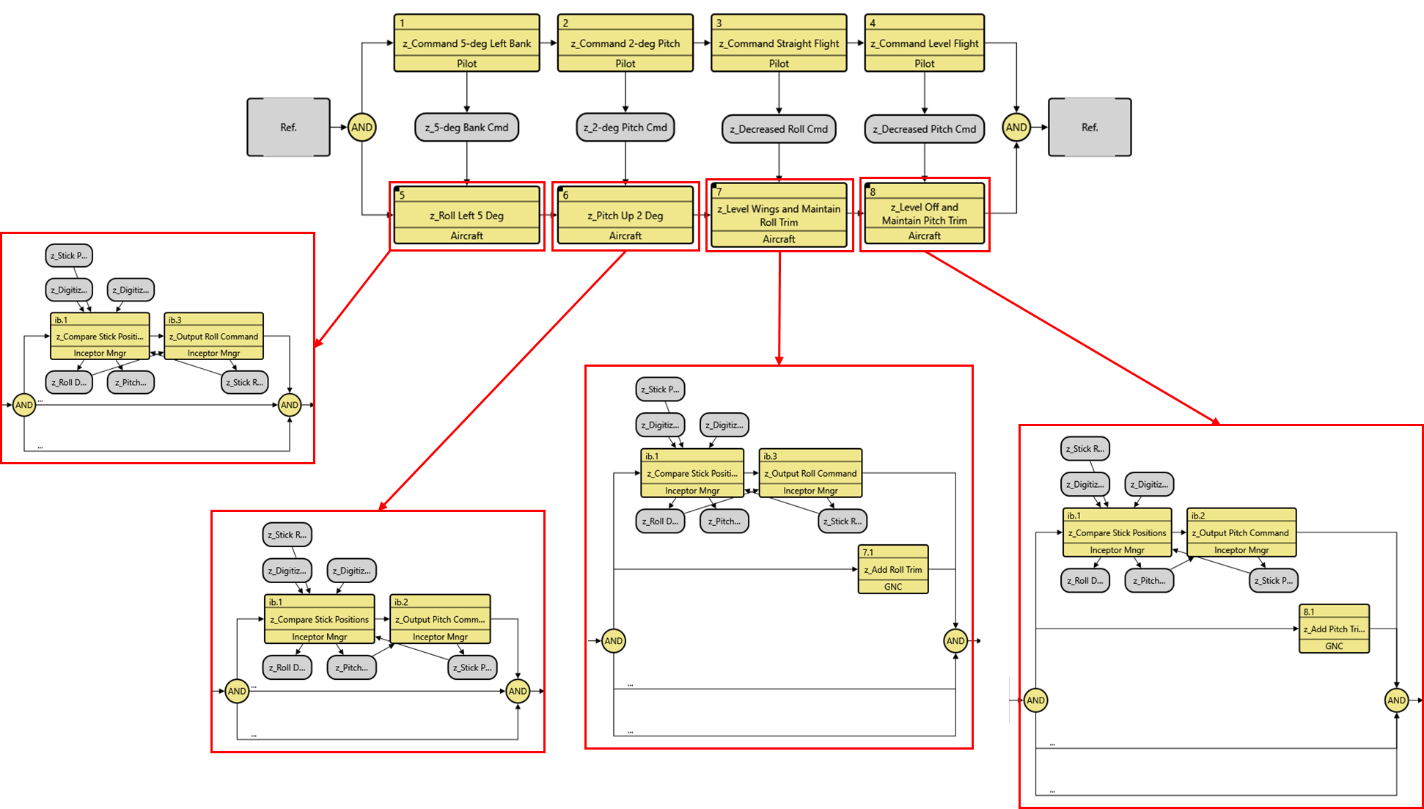The following tale is a fictional account of representative events. Any resemblance to actual events, persons or organizations is completely unintended. Technical details presented in the storyline are available academically and publicly. No government or proprietary information was disclosed.
“Okay, explain to me again why we can’t just create more functions at the system level and add this new feature? That seems like a lot of extra work to solve one problem,” Bryan Jackson, head of Vehicle Management System, said with irritation. He had hoped his team’s work on the VMS-logic to reset the MMC meant the end of the problem.
“We actually have two problems and a half. The ‘half’ is we cannot let VMS auto-reset the MMC for the reason Luke just stated. It’s only ‘half’ because it’s related to problem number one: not knowing how to command a manual reset. And problem number two is we are impacting the overall operation of the aircraft with a new atomic function.” Podolski paused to let the context sink in before he continued.
“Frankly, ‘number one’ is a VMS and Mission Management’s problem. You guys in Engineering can solve it, but only after we in Systems have solved ‘number two.’ We can’t just ‘bubble up’ this function through the already existing integrated behavior because… Let’s just say that Luke needs to run through a pilot checklist as part of the MMC reset sequence. This stimulus from the pilot-user will invoke a few functions to respond: from Display, Mission, VMS. All to satisfy the AOKAY condition to reset the MMC. Are you going to rip these existing functions from their existing partitions to make up another parent function in the integrated behavior? – No, even if you only copy these functions to a new partition, you have changed the functional flow within each of the Display, Mission, and VMS CSCIs. The execution frequency and timing of each atomic functions are no longer maintained within their respective CSCI.
Instead, we are going to show the impact of the new functional behavior in the operational domain. The operational activities leading to, during, and after the MMC reset are decoupled from the functional integrated behavior in term of the decomposition hierarchy. But, they are tied to the relevant functions through the implemented by relationship. With the two domains decoupled but tied through a relationship, we can model and demonstrate a new system usage while maintaining the functional structure.”
“My head hurts,” said Carlisle. The rest of the meeting attendance did not look too amused either, except for Hannah Grove, who had been taking notes since the start of Podolski’s explanation. Recognizing that he had made no further progress with the group, Podolski suggested a ten-minute recess for everyone but himself and Grove. He wanted to build a quick example in GENESYS to get the point across. After all, a picture was worth a thousand words.
Ryan took the opportunity to refill his Yeti with some breakroom coffee – the kind you needed a ton of cream and sugar to make tolerable. Not immune to the “lowest-cost government-contract” business practice, Frontier Aeronautics just could not afford the overhead for decent African dark-roast. This could rival the jitter juice on the Big Stick, he thought, but Ryan did not seem to mind as he made his way back to the meeting room. Hannah Grove was now running the overhead projector, which was illuminating the screen only five feet from Ryan’s seat. He turned his chair to face the screen, leaning far back in it to observe the projected content.

Podolski made his way toward the projector screen. He picked a spot so that the meeting attendees could all face him while following the presentation content. He spoke with a measured but upbeat voice.
“Thank you for restarting on time. Hopefully, we can get through this in ten minutes. Suppose, this is how our Inceptor Manager in the VMS works to read a flight-stick input to command manual pitch and roll for the GNC. These functions execute in a pre-defined loop frequency, specific to the Inceptor Manager CSCI. This part of the functional flow is already defined in our system integrated behavior. Now, if we want to use the functional domain to demonstrate how the pilot uses the stick to hand-fly, as an example, it would look like this at the context level.”
Grove opened a new window on the projector screen:

“If we try to fit our existing Inceptor Manager behavior into the decomposition of 5, 6, 7, and 8, it would look like this,” continued Podolski. A PowerPoint slide was now projected on to the screen:

“We have essentially broken how the Inceptor Manager CSCI is supposed to work. When we mix system operations and implementing functions, we force the functional behavior to work the way the system usage is laid out and not how the real atomic functions work together to implement such usage.”
“And therefore, every time the user comes up with a new way to use the system, we’d essentially modify the integrated behavior, incorrectly,” exclaimed Austin.
Some heads started to nod around the room; other mildly confused faces were still glued to the projector screen. But the general mood was rather absorbent than skeptical. Podolski seized the opportunity to bring it home.
“I know this is a lot of work, folks, especially if we need to go back and complete an operational model for all phases of flight. But if we missed this one operational activity of the system for a simple reset function, we probably have missed other more critical operations. We are a champion for digital engineering. Correct? We need to connect the components to functions, to operations, in one authoritative source of truth. Maybe not? – We could use the operational models piecemeal as problems occur. It doesn’t make much sense to me, but this will be Ron’s call. It turns on cost-impact”
Ryan remembered Ron Sheen was the CEO of the company. If Mr. Sheen’s welcome message to the new-hires was to hold true, this initiative was a must, Ryan thought. A digital engineering framework was not complete unless the physical architecture was connected to the integrated behavior, which was connected to the operation of the system. All three were to be connected to their respective requirements. Some light started to shine on Ryan’s understanding of where Frontier Aeronautics was headed with systems engineering. A complete metamodel was not built upon three domains. It was actually based on four: Requirement, Operational, Functional, and Physical.
“. . . So can you help us define the pilot activities?” Podolski’s question interrupted Ryan’s surprisingly deep contemplation, “They will fit into Bob’s simulations quite nicely as well. Hannah will set up a time with you this week.”
“Ah yes, of course. This is why I am here instead of flying the Dreamliner for United,” Ryan grinned.
“Or the A300 for FedEx. I hear that cargoes don’t mind a Dutch roll or two if you happen to be in the mood!” Fraser injected quickly and gleefully.
Laughter erupted around the room. Podolski concurred with Austin to adjourn the meeting. As people filtered out of the meeting room, Podolski caught up with Ryan in the hallway.
“Commander Luke ‘Meg’ Ryan?”
“Ha! Yes, that’s me. I was hoping for ‘Jack’ but the boys wouldn’t have it any other way.”
“I saw your F-18 on the Roosevelt! I was there for the X-Bravo testing in 2013. Fun time at sea.”
“Ah yes, you guys pulled off some dark-magic tricks with that big drone. You were going to replace all of us pilots. Now look at us, we are designing full squadron of men and drones!” Ryan’s eyes brightened up as he made the connection between his sea-story and his present endeavor.
“It was a wonderful assignment, living with and learning from the crew. I wish every engineer here had a chance to experience such a day-in-the-life. Engineers think and talk very differently than the pilots and crew they design the product for,” Podolski reflected.
“Different, yet connected. Just like operations and functions!” Ryan quickly added.
Podolski chuckled, “Not bad for your first day in systems engineering. Glad you’re with us! Again, welcome to the team!”
With that, the two men shook hands and headed separately for their office. Back there, Lieutenant Commander Luke Maxwell Ryan, USN, Retired stepped off his old boat and into his new engineer’s shoes.






